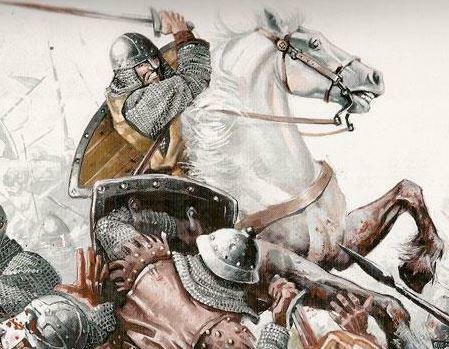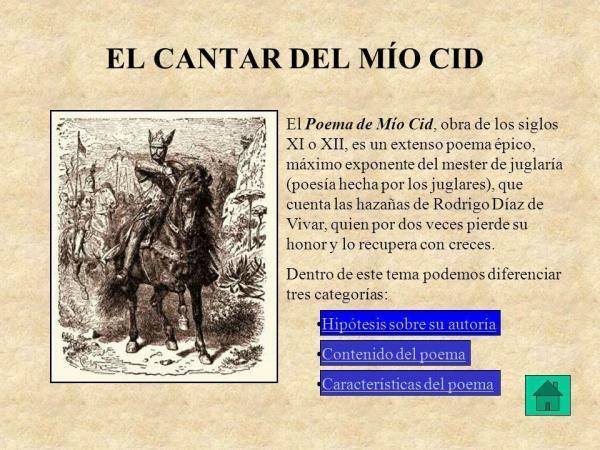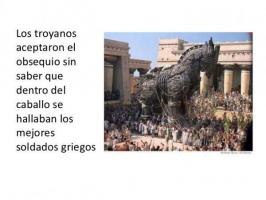The legend of the Cid Campeador

All peoples need heroes and Rodrigo Díaz de Vivar, also known as the Cid Campeador, exactly fulfills this figure within Castilian history and iconography and the so-called Spanish reconquest, mixing legend and truth in equal parts. Next, in this lesson from unPROFESOR.com, we are going to investigate this legend so we will discover a short summary of the Cid Campeador so that you get to know this well-known character better.
Index
- El Cid, between legend and history
- Early years of the Cid Campeador
- Knight in the service of the king
- Exile of Castile and León
- Last stage of his life
- The Song of Mine Cid
El Cid, between legend and history.
The complexity of making a story of the life of Rodrigo Díaz de Vivar is a fact, because it is diluted between reality and legend. El Cid has been one of the best known characters of the Spanish Middle Ages, embodying the figure of the undefeated knight that through his deeds it was a fundamental pillar and mirror in which to fixate during the conquest of the Peninsula carried out by the Christian kingdoms. In this other lesson we discover a
summary of the Spanish Reconquest.Epic poetry especially helped this, with a large number of poems that glossed his exploits, the best known being the Poem of Mine Cid, the sing of deed most outstanding of the Castilian epic. Therefore, the Cid was erected during the mester of minstrel as a literary character, model of the perfect knight, with which to harangue the Christians to conquer territories to the kingdoms Muslims.
Further from this idyllic figure is the historical figure, a gentleman who was born in Vivar (Burgos), between 1045 and 1049, being a vassal of the monarchs Sancho II and Alfonso VI of León and Castilla, but who also served the Taifa kingdom of Zaragoza Y he fought against the Almoravids on the Peninsula, conquering the kingdom of Valencia in 1094.

Image: Slideshare
Early years of the Cid Campeador.
Rodrigo's father, Diego Lainez, He was a second-rank nobleman who stood out in the war against Navarre that Fernando I of Castilla y León fought, obtaining possessions in Vivar. Rodrigo grew up in the retinue of the infant Don Sancho, heir to the kingdom, being named by this knight and entering battle with him for the first time in Graus (1063).
After the death of Fernando I (1065), the distribution of his kingdom between his children gave rise to a civil war, facing Sancho II, Alfonso VI and the infanta Doña Urraca. Rodrigo was the ensign or standard bearer of Don Sancho in the conflict, achieving the nickname of fighter or ‘Campeador’, with which he will be known both among Christians and Muslims.
Knight in the service of the king.
The contest ends with the death of Sancho II and with Alfonso VI retaining the throne. Although according to the legend of this time the future enmity between El Cid and Alfonso VI was due to the fact that the knight forced the king to swear not to have had to do with the death of his brother, none of this happened, Y Rodrigo was part of the Alfonsine court, having the confidence of the king, who gave him important positions and even married him to a relative of his, his cousin doña Jimena Díaz, achieving in this way Rodrigo Díaz de Vivar position himself as a nobleman of the first row.
It is true that finally El Cid fell from grace in front of Alfonso VI, but this was mainly due to political causes, since he made an incursion in the kingdom of Toledo without the monarch's permission, which other noble rivals of the Cid took advantage of to pressure the king to banish him, a fact that produced.

Image: Slideshare
Exile of Castilla y León.
After the exile, the Cid puts his sword at the service of King Almutamán, monarch of the taifa of Zaragoza. This fact was not strange at the time, since the courts of the Muslim kingdoms of that time were a refuge for Christian knights who sought refuge due to disagreements with the nobles of the north.
El Cid will battle against Almutamán's enemies and will achieve great victories, and for a time he will also be under the command of his successor, Almustaín. But the arrival of the Almoravids to the Peninsula, that will put King Alfonso VI in serious trouble, made him reconsider his decision to exile the Cid and forgave him.
Alfonso VI will assign the Cid to control the eastern part of the Peninsula. In this situation he will begin to collect for himself in Valencia and in the other Levantine territories the tributes that were previously paid to the Catalan counts or the Castilian monarch. The lack of support of the Cid to the Castilian monarch in the siege of Aledo (1088) led to his banishing him again and confiscating his assets, becoming the Campeador an independent caudillo.
Last stage of her life.
As a leader, el Cid achieved important victories against Berenguer Ramón II, Count of Barcelona, and the Taifa of Lérida, united to put pressure on the Levantine area. Later, before a new attack by the Almoravids, El Cid changed his protectorate policy to one of conquest, initiating a control of squares in the Levante area.
This new stage reached its culmination on June 15, 1094 with the taking of Valencia, adopting the title of ‘Prince Rodrigo the Campeador’, and getting the arabic treatment of sidi, my lord, origin of the nickname of Cid, with which he would be known.
Despite these successes, the pressure from the Almoravids did not cease and the Cid stood up to them until his death, due to natural causes, in May 1099. With his disappearance, one of the most notable characters of his time said goodbye, thus beginning his legend.
The Song of Mine Cid.
One of the pillars of the legend of the Cid Campeador is based on epic poetry and especially on ‘El Cantar de Mío Cid’, which is also the first work of any importance in Spanish literature in the Romance language. The work, which mix both reality and fiction, recounts the exploits of Rodrigo Díaz de Vivar in the last years of his life, enhancing his hero qualities.
Constituted as the most famous deed song of the Castilian epic, is an anonymous work, although some experts believe that it was initialed by Per Abbat about the year 1207. Other theories indicate that it was written in the 12th century, shortly after the death of El Cid, its authors being two minstrels, one from Medinaceli and another from San Esteban de Gormaz, because these are described very well in the poem. places.
The figure of the Cid is represented in the poem in an idealized way, underlining his great heroism in battle and his fidelity to the king despite having unjustly banished him. In addition to being a great warrior, a profile of a tender person, a great believer and very faithful is drawn. Broadly speaking, a model of a medieval Christian hero is represented, who fights for his king against the enemies of his country and his religion.

Image: Slideplayer
If you want to read more articles similar to The legend of the Cid Campeador - Short summary, we recommend that you enter our category of Story.



